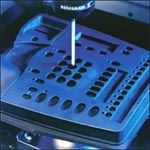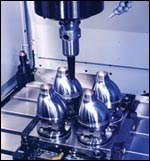How to Select and Use Your Vertical Machining Center
Competitive shops need to consider the true capabilities of their VMCs to achieve a high level of accuracy and surface finish.
Dramatic changes continue to sweep through the North American die/mold industry. Overseas competition is forcing North American manufacturers to re-evaluate their processes and manufacturing techniques to reduce costs and minimize leadtimes.
These changes are causing a primary shift in manufacturing applications toward more automated techniques and process-driven approaches. This in turn is changing the way in which die/mold shops are selecting and using vertical machining centers (VMCs). This shift is forcing a change in the capability that these shops require from their machining centers in order to remain globally competitive.
Competitive Shops
The most competitive die/mold shops today are adopting techniques that allow them to reduce or eliminate bench work, polishing and the fitting of mold components. For these shops, first-part sampling has moved from a process of sampling, adjustment and re-sampling to one requiring no adjustments. This is achieved through implementation of techniques such as cutting parting lines and mating surfaces to zero or negative stock.
Machining to very tight tolerances between mating components is mandatory, so that no hand fitting is required. It is possible to achieve this with parting surfaces, insert to pocket fits, as well as in 62-64 HRc die components.
To achieve this level of accuracy and surface finish; however, competitive shops need to first consider the true capabilities of their VMCs. This is not limited to what a spreadsheet indicates the performance of the machine will be, but by verifying the real accuracy and surface finish capabilities that the equipment will deliver.
This new level of quality, achieved day after day without a lot of adjustments and manual maintenance of the process, is essential to remaining globally competitive. The best VMCs available today allow a shop to implement solutions-based techniques without intensive process monitoring by the floor employees.
Performance, Not Specs
VMCs can no longer just be selected by analyzing a spreadsheet that compares spindle horsepower and torque, X/Y/Z travels and purchase price. In order to achieve results that will be competitive in the global market, shops must consider aspects of machine performance that will produce extremely high accuracy and superior surface finish requirements.
Spindle design, thermal stability and the construction and stability of the machine become more important aspects to consider in a VMC than horsepower and torque values. Spindle design is a critical component in achieving a perfect fit between components, without manually fitting those components.
High-performance spindles will maintain extremely stable Z-axis accuracy. This requirement is paramount toward the elimination of manual fitting. If a spindle is not capable of maintaining very tight Z-axis accuracy, there will be no possibility of achieving a machined fit between mating components.
The best VMC spindle systems available on the market today have cooling systems that thermally control the internal workings of the spindle as well as the outer housing. This removes the heat at the source and eliminates the need for complex software or hardware systems to predict and compensate for thermal growth.
Additionally, the chillers responsible for stabilizing the spindle must be variable capacity units and be very accurate. Chillers need the capability to continuously monitor the VMC spindle temperature and adjust the cooling capacity. These should maintain temperature within one degree Celsius in order to provide the level of stability required to eliminate manual adjustments to components during assembly of the die or mold.
Once a highly stable spindle is used, then automatic tool length measurement systems can add the next level of accuracy to achieve very accurate tool-to-tool blends. This in turn allows the use of highly accurate tooling to achieve the maximum results in quality and surface finishes.
Vertical Designs
Machine design needs to follow modern technology philosophies. A traditional VMC is not designed with attention to heat build-up and volumetric stability.
At feedrates of 20 to 40 inches per minute, this was not a concern. With the capability today of machining at hundreds of inches per minute, machine casting and design demands have dramatically changed.
Thermal stability needs to be designed and built in to the casting of the VMC itself. With the high rpm spindles and high torque servo drives presently available, these components can induce significant heat into the machine casting.
Designed incorrectly, a casting can suffer significant thermal deformation. This will cause a collapse of volumetric accuracy, forcing a shop to invest in costly and continuous manual adjustments of the machine in order to get machined components to fit correctly. This then causes a '"domino effect" on extending leadtimes and raising costs to complete a mold or die.
Designed with these issues in mind, however, today's VMC can maintain extremely accurate volumetric accuracy over very long cycle times required. This will help die/mold shops deliver quality components that require no manual finishing or fitting.
High-Performance CNC
Once the structure and mechanical components of a properly designed, thermally stable machine are in place, then a high-performance CNC control is required to fully implement the capabilities of modern CAM systems and tooling. During acquisition of a VMC close attention should be paid to how the control system processes and handles the data.
The control must be focused and designed to provide maximum accuracy in order to eliminate fitting and benching requirements for molds and dies.
Many controls today convert the supplied toolpath data from its original data into a spline, such as a NURBS-style toolpath. This conversion process can help a machine tool move through complex geometry at very high feedrates that are impressive to watch.
However, such a conversion also can induce excessive inaccuracy into the cut, causing manual fitting to be required. Look for a control that obeys the geometry that the CNC program provides, and one that will take action to obey that geometry when the feedrate and servo acceleration limits are exceeded.
Don't Stop There
With a technologically advanced machine design and rigid construction for high-performance usage, and with a highly stable spindle and a high-performance control, you can be sure you have a VMC that will provide dramatic cost and leadtime reductions.
But, it is not enough to stop here and expect to get these results. With the properly selected VMC in place, attention must be paid to CAM systems and tooling as well.
Recent CAM system advances are key to achieving maximum results with a technologically advanced VMC. The ability to produce very accurate toolpaths with very tight chordal tolerances are critical.
They also provide the flexibility to allow the user to modify lead-in/lead-out, cutter engagements and other details of the toolpath. These issues become very important to achieving reliable, repeatable results, especially in an unattended manufacturing system.
Balanced toolholders are critical to achieving both accuracy and surface finish requirements. The use of cutting tools with highly accurate form control cannot be overstated.
High quality cutting tools typically have tolerances of 0.0005 inches, which are greater than those often required in the die/mold industry today. For even more precise requirements, cutters with tighter tolerances also can be used.
Getting Results
Achieving dramatically shorter leadtimes and reduced manufacturing costs in vertical machining are mandatory requirements to competing in today's global die/mold market arena. However, in order to succeed it is necessary to review all current manufacturing processes.
Question whether or not there is an innovative new way to reduce costs in your operations and to take advantage of advanced vertical machining technology. This will require important and continuous research in finding the finest new products and innovations available.
This research will bring additional efficiencies to your die/mold operations, particularly due to vertical machining advancements. Being proactive in the global market will allow shops to maintain a global competitive advantage.
Related Content
Speed, Productivity Gains and High Uptime Ease Decision for Second Five-Axis Machine
Byrne Tool + Design reduced setups and gained speed and productivity thanks to fast, accurate and compact five-axis CNC machining centers.
Read MoreMachining Center Spindles: What You Need to Know
Why and how to research spindle technology before purchasing a machining center.
Read MoreDevelopments in High-Speed Machining Technology
There have been many exciting developments in high-speed machining relative to machining centers and controls, tooling and CAD/CAM systems.
Read MoreThe In's and Out's of Ballbar Calibration
This machine tool diagnostic device allows the detection of errors noticeable only while machine tools are in motion.
Read MoreRead Next
Selecting an Economical VMC for Mold Machining
The key to investing in the right vertical machining center is in sizing up your current process requirements and machining capabilities, while factoring in future work.
Read MoreHow to Use Continuing Education to Remain Competitive in Moldmaking
Continued training helps moldmakers make tooling decisions and properly use the latest cutting tool to efficiently machine high-quality molds.
Read MoreAre You a Moldmaker Considering 3D Printing? Consider the 3D Printing Workshop at NPE2024
Presentations will cover 3D printing for mold tooling, material innovation, product development, bridge production and full-scale, high-volume additive manufacturing.
Read More


















_300x250 3.png;maxWidth=300;quality=90)



.jpg;maxWidth=300;quality=90)








